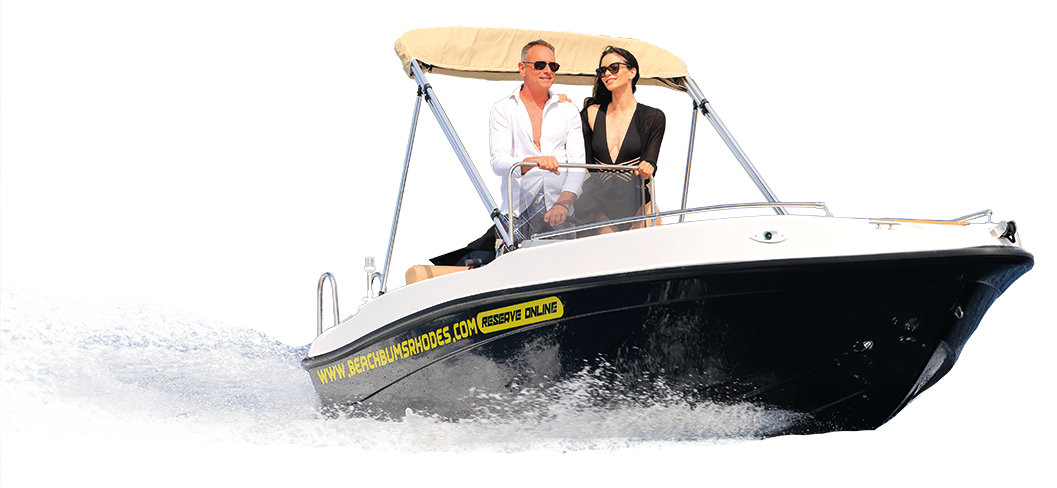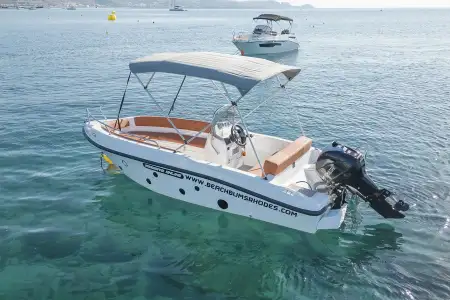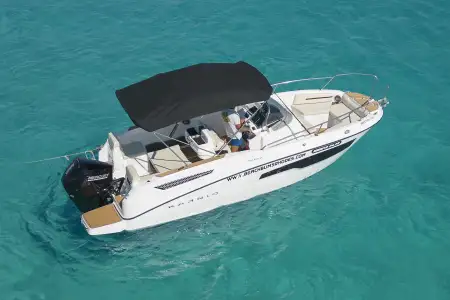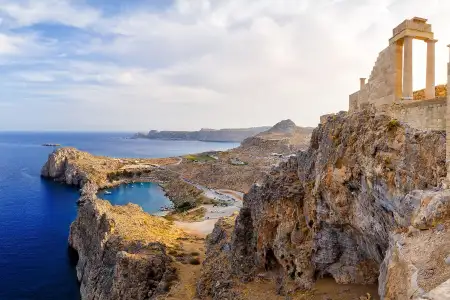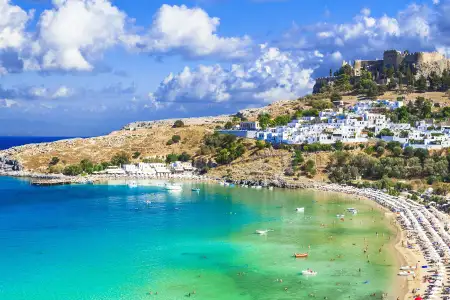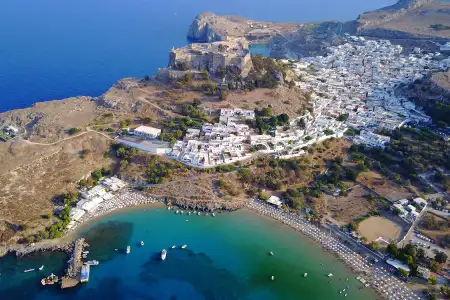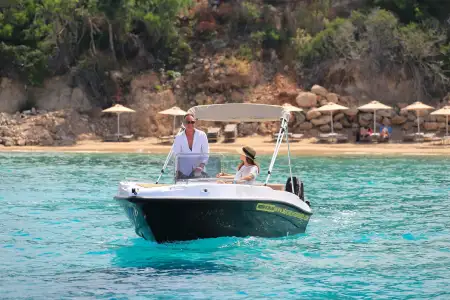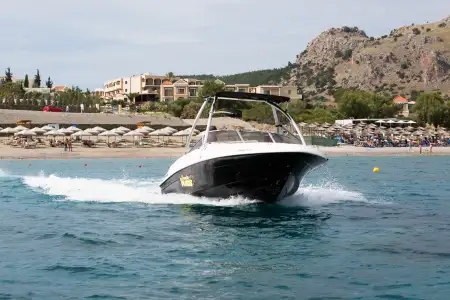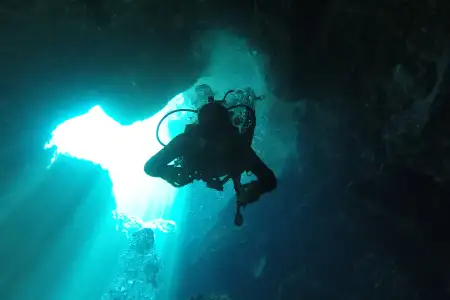
The History of Rhodes
Introduction
Like the rest of Greece, the island of Rhodes is located at the crossroads of two major sea routes of the Mediterranean between the Aegean Sea and the coast of the Middle East, as well as Cyprus and Egypt. This meeting point of three continents, it has known many civilizations. Its strategic position brought to the island great wealth and made the city of Rhodes one of the leading cities of the ancient Greek world.
Rhodes is the largest island in the Dodecanese. Its capital city, located at its northern tip, is the capital of the Prefecture with the Medieval Town in its center. In 1988 the Medieval Town was designated as a World Heritage City. The Medieval Town of Rhodes is the result of different architectures belonging to various historic eras.
Mythological Period
When the gods divided the earth between them, Rhodes did not show on the surface of the sea, it was immersed. Helios (Sun) was away on his usual trip and the other gods forgot to give him a share. When Zeus heard about it he wanted to redistribute the earth. Helios (Sun) yet did not allow him to do this , due to the fact that he could see a new region immersing from the sea and asked to be given that one. Zeus invited Lahesi to give oath that the new region would be the share of Helios (Sun). So the beautiful island came up to the surface of the sea and they gave it to God Helios (Sun).
This myth that is created by persons imagination, tries to interpret the different events. The surfacing of the island of Rhodes from the ocean is relative to the subsidences, that are mentioned in Geology relatively to the forming of the land. The love of Helios for Rhodes is explained with the sunny days that Rhodes has nearly all year round. This is why they called Rhodes the Nymph of Helios - Sun and they still think of Rhodes as the daughter of Aphrodite that emerged from the ocean.
In Greek mythology, Rhodes was thought of as a daughter of Poseidon with any of several primordial sea-goddesses— with whom she might be identified herself— notably Halia or Amphitrite. Pindar even urges his hearers to "Praise the sea maid, daughter of Aphrodite, bride of Helios, this isle of Rhodes." "All three names— Halia, Aphrodite, Amphitrite, and furthermore also Kapheira— must have been applied to one and the same great goddess".
In Rhodes, to which she gave her name, she was the consort of Helios, as Pindar says, and a co-protector of the island, which was the sole center of her cult. Her name was applied to the rose, which appeared on Rhodian coinage.
The first inhabitants of Rhodes were identified by Hellenes as the Telchines. Helios made the island rise from the sea and with Rhode, fathered seven sons there, the Heliadae: Ochimus, Cercaphus, Macareus, Actis, Tenages, Triopas, and Candalus) and one daughter, Electryone. Electryone died a virgin and the sons became legendary astronomers and rulers of the island, accounting for the cities among which it was divided. Kerkafos had three sons Kamiro, Ialiso and Lindo, they divided the island into three major districts and each one of the sons had his own town and they named them after themselves. Rhode was worshipped on Rhodes in her own name, as well as Halia, the embodiment of the "salt sea" or as the "white goddess", Leucothea.
Classical Period
The island was inhabited as early as the late Neolithic period (4000 B.C.). In 408 B.C. the three major cities of the island - Ialyssos, Kamiros and Lindos - founded the city of Rhodes. The three centuries that followed were the golden age of Rhodes. Sea trade, skilled shipbuilders, and the careful and open-minded political and diplomatic maneuvers of the city kept it strong and prosperous until Roman times.
In the same period, Rhodes produced excellent artistic work. The most celebrated of all was the Colossus, one of the Seven Wonders of the Ancient World, made between 304 and 293 B.C. by the Lyndian sculptor Hares. The construction of the Colossus took 12 years and was finished in 282 BC. For years, the statue, representing the sun god Helios, stood at the harbor entrance, until a strong earthquake hit Rhodes about 226 BC. The city was badly damaged, and Colossus was demolished.
The urban plan of ancient Rhodes reflects directly the urban and philosophical ideas of the famous ancient Greek planner, Hippodamus. The ancient city had an extended and well-constructed sewage system as well as a water supply network.
Roman Period
The independence of the city came to an end in 164 B.C. when Rhodes became a Province of the Roman Empire. But even as late as the 1st century A.D. Rhodes developed into one of the greatest centers of learning, science and arts.
Byzantine Period
During the early Christian period (330-650 A.D.) Rhodes belonged to the eastern part of the Christianised Roman Empire, which is known in history as the Byzantine Empire.
Though less significant and prosperous than before, the city was the See of a Bishop and had a great number of churches, among them some basilicas of impressive dimensions.
The Arabs, who appeared or the first time in the Mediterranean in the 7th century, attacked Rhodes and occupied it for sοme decades. The city shrank during the following centuries and was fortified with new walls. At the same time it was divided into two zones, one reserved for the political and military leadership and the other where the laymen lived, a division that reflects the social reality of medieval times.
Knights' Period
In 1309 the island was sold to the Order of the Knights Hospitaliers of Saint John of Jerusalem. The Order was established in the 12th century in Jerusalem for the purpose of nursing pilgrims and crusaders, but soon enough it was transformed into a combat unit and acquired vast tracts of land.
Having retreated from Jerusalem and then Cyprus, the Order established its Headquarters on Rhodes, taking a leading role in the Eastern Mediterranean at this time.
During the Knights' era the fortifications were extended, modernized and continuously reinforced. Α hospital, a palace and several churches were among the many public buildings constructed at that time, offering interesting examples of Gothic and Renaissance architecture. Ιn spite of the hostilities with the Ottoman Empire, sea trade was a source of wealth and the markets of the city were thriving. Most of the streets of the Medieval Town coincided with those of the ancient city. The division of the town into two parts was retained. in Rhodes the Order kept a well-organized archive that included documents issued by its leadership, correspondence, notary acts, etc. The archive has survived and is found today in the National Library of Malta. It constitutes a valuable source of information for the period.
The city was divided into its two parts by an inner wall. The Northern part, known as Chastel, Chateau, Castrum, Castellum or Conventus, was the site of the Grand Masters Palace, the church of the Knights, the Latin Cathedral, the Catholic Bishops residence, the various tongues quarters, the Knights houses, a hospital etc. The South part, known as ville, burgus or burgum was the area where the laymen lived and included the market, churches and public and commercial buildings.
Ottoman Period
In 1522 the Ottoman Turks conquered the city after a second long siege. New buildings were constructed: mosques, public baths and mansions for the new patrons. The Greeks were forced to abandon the fortified city and move to new suburbs outside its walls.
In the Ottoman era Rhodes lost its international character. The city maintained its main economic function as a market for the agricultural products of the interior of the island and the surrounding small islands.
After the establishment of their sovereignty οn the island, the Ottoman Turks repaired the damaged fortifications, converted most of the churches into mosques and transformed the major houses into private mansions or public buildings. This transformation was a long-term process that aimed to adapt the buildings to the Ottoman way of living. The Knights period facades with their sculptured decorations, the arched gates and hewn stone walls were enriched with the random character of the Ottoman architecture adapted to the local climate and culture. Ιn this process most οf the architectural features of the existing buildings were preserved. The most characteristic additions were the baths (usually in the back of the buildings) and the enclosed wooden balconies οn the facades over the narrow streets. The result was a mixture of oriental architecture with imposing western architectural remains and more recent buildings, which were characteristic of the local architecture of the time.
Ιn the l9th century the decline of the Ottoman Empire resulted in the general neglect of the town and its buildings, which further deteriorated due to the strong earthquakes that often plague the area.
Italian Period
Italian troops took over the island and the rest of the Dodecanese in 1912 and in 1923 Italy established a colony Isole Italiane del Egeo.
The Italians demolished the houses that had been built on and beside the walls during the Ottoman era. They preserved the remains of the Knights' period and removed all the Ottoman additions and also reconstructed the Grand Master's Palace. In addition, they established an Institute for the study of the History and Culture of the region.
The Italians undertook extensive infrastructure works (roads, electricity, port, etc.) and radically transformed the town of Rhodes, which was supplied with a new urban plan, building regulations and many new public and private buildings.
Modern Period
The English bombs that fell on the medieval city of Rhodes in 1944 claimed human lives and destroyed a great number of buildings, leaving large gaps in the urban tissue. One of the first Decrees of the Greek administration designated those areas as reserved for future excavations and a number of edifices as safeguarded buildings.
In 1957, a new city plan was approved by a Decree and in 1960 the entire medieval town was designated as a protected monument by the Ministry of Culture. In 1961 and 1963 new Decrees were issued concerning the new city plan. They provided for the widening of existing streets and the opening of new ones. These were not implemented in the old city due to the resistance of the Archaeological Service. In 1988, the old town of Rhodes was designated as a World Heritage City by UNESCO.

Rent a boat
A unique opportunity to swim at turquoise waters of Navarone bay and visit delusional landscapes of the famous St Paul’s bay under the ancient acropolis of Lindos.
more information
Get a private cruise
A unique opportunity to visit incredible landscapes and swim in turquoise waters. We take you around the southeast coast to see the most memorable areas in this part of Rhodes.
more informationCruises, Activities & more...
Why Choose Us
Our intention is to reveal the beauty of our island and to provide our customers with high-quality activities, in the same way that we would like to experience them ourselves. Also, we are geared towards caring for our customers, offering only the best maintained equipment, coupled with the maximum standards for your safety on board.
Our prices are competitive and fair. There are no hidden charges. Any unexpected or additional expenses must be pre-approved by you. That’s how we would like to be treated, and that is how our customers are treated.
- Brand New equipment
- Pay on arrival No deposits
- Pick up and drop off service
- Full Insurance
- Customer Care
- Detailed Safety Briefing

